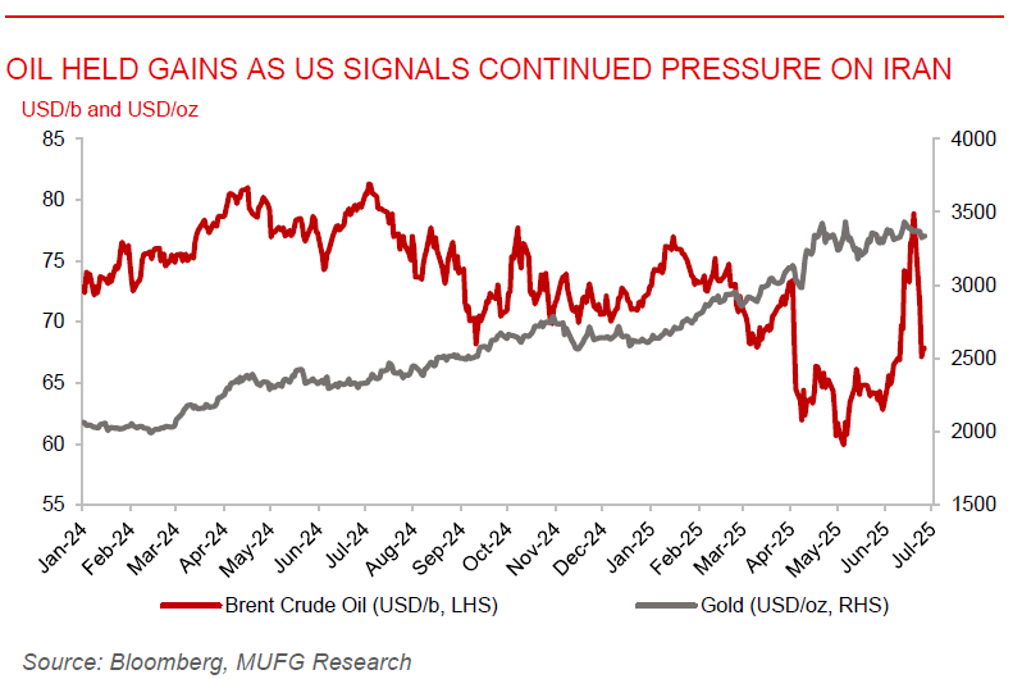To read the full report, please download the PDF above.
Middle East Daily
SOOJIN KIM
Research Analyst
DIFC Branch – Dubai
T: +44(4)387 5031
E: soojin.kim@ae.mufg.jp
MUFG Bank, Ltd. and MUFG Securities plc
A member of MUFG, a global financial group
Middle East Daily
COMMODITIES / ENERGY
Oil held gains as US signals continued pressure on Iran. Oil prices stabilise near recent highs on 25 June, with Brent hovering around USD68/b, after US President Trump reaffirmed his commitment to pressuring Iran’s oil exports despite earlier mixed messaging. While tensions in the Middle East have cooled following the Israel-Iran truce, oil markets drew support from a sharper than expected 5.84 million barrel decline in US crude stockpiles, pushing inventories to an 11-year seasonal low. Refinery demand surged as gasoline consumption hit its highest since late 2021, driven by strong summer travel. Looking ahead, market attention is shifting toward the OPEC+ meeting on 6 July, where discussions on a potential output increase are expected. Near-term price support may persist due to tight inventories and seasonal demand, though easing geopolitical risks and demand uncertainties could temper further gains.
Gold inched higher as dollar weakens and Fed uncertainty lingers. Gold edged up to around USD3,338/oz today, supported by a weaker dollar and lingering caution around Middle East tensions and US interest rate prospects. A dip in the US currency made bullion more affordable, while other precious metals surged. Although President Trump declared the Israel-Iran conflict “effectively over”, he left open the possibility of renewed fighting. Meanwhile, markets are awaiting clearer signals from the Fed, as Chair Powell flagged uncertainty around the inflation impact of Trump’s tariff agenda. While muted inflation could open the door to rate cuts, typically supportive for gold, expectations have been tempered by the Fed’s cautious tone. Despite gaining more than 25% this year, gold’s momentum has cooled in recent months, with prices still about USD160 below record highs.
MIDDLE EAST - CREDIT TRADING
End of day comment – 25 June 2025. Constructive day with spreads continuing to grind tighter. Flows were mixed with some selling of QATAR from RM and ETF flows turning to sellers in the afternoon. But the street seems to be happy to absorb these selling flows and even absorb them at tighter spreads. IG sovereign closing 3/5bp tighter, long end bonds outperforming as shorter end bonds are not attracting interest at lower yields/spreads. ADGB 54s +0.375/-4bp and QATAR 50s +0.375/-4bp leading the way. In higher beta names MOROC continues to outperform OMAN with a good bid in the belly today, 32s closing +0.25pt/-6bp. Against this OMAN had a quieter day and saw some sellers in the afternoon but still closed a touch higher in cash prices and -2/3bp. Quasis and corps were quiet but on the back of weaker macro markets started to see sellers into the close. The market overall still feels strong, after 2 days of significant tightening though it looks like we are starting to see some profit taking/ sellers stepping in. Credit curves remain steep and today was the first day in a while that long end outperformed.
MIDDLE EAST - MACRO / MARKETS
Saudi oil revenues hit 4-year low amid April price crash. Saudi Arabia’s oil export revenues fell to USD16.5bn in April, the lowest in nearly four years as Brent crude prices plunged over 15% that month, driven by US tariff shocks and OPEC+’s surprise move to accelerate output increases. The drop represents a 21% y/y decline and a 7% dip from March, adding fiscal pressure as the kingdom maintains high spending on its Vision 2030 agenda. While Brent has since recovered to around USD68/b prices remain 9% lower YTD. Prolonged weakness near USD65/b could widen budget and current account deficits, increasing the need for borrowing or fiscal adjustments. For now, Saudi Arabia’s solid financial buffers provide short-term stability. Attention now turns to the OPEC+ meeting on 6 July, where the kingdom is expected to support further production hikes to manage supply and stabilise the market.
IMF disbursed USD834 million to Jordan. The International Monetary Fund disbursed USD834 million to Jordan, including USD134 million under the Extended Fund Facility (EFF) and USD700 million through the Resilience and Sustainability Facility (RSF). The funds aim to support Jordan’s economic program and address long-term challenges in water, energy, and health sectors. The IMF praised Jordan for consistently meeting EFF targets, maintaining macroeconomic stability, and achieving 2.5% growth in 2023, with stronger than expected momentum in 2024. The IMF emphasised the need for continued fiscal reforms, efficiency in public utilities, and private sector development, while calling for sustained donor support to help Jordan manage regional challenges and host its large refugee population.

